There’s something intriguing about Hayley Beresford, because although she was successful in Australia (she was a member of the Australian Young Rider Squad and had a couple of State titles to her credit), she was relatively unknown before bursting onto the International dressage scene under the wing of Isabell Werth. Then she not only made the Australian team for Beijing after just eight months of Grand Prix competition with the Lusitano Stallion, Relampago do Retiro, but was the star of it, despite the selectors best efforts to shun her from the selection process.
I met Hayley for the first time at the World Equestrian Games, where she had fought her way onto the team despite making some big changes, leaving her mentor in Germany for a life in Switzerland: “My husband couldn’t have a Visa in Germany. It was very difficult for me to leave Isabell’s but you can’t have a husband who can’t work, and Isabell is an incredibly busy person. She will always be my mentor, she will always be the person I call when things go wrong.”
Hayley and Relampago – he is on the way back…
After making many sacrifices to get to Kentucky, a niggling injury surfaced in the Grand Prix and Relampago was belled out. When she came to Queensland on her Australian coaching tour, the shock had finally worn off:
“I was eliminated from the World Equestrian Games. Which, when you think of it, you’re like, oh that’s not cool. But it was a big lesson learnt. I don’t think that we would change anything now. There was something underlying and we did every test we could possibly do to see if it was really bad, and nothing showed up.”
At the time, she put on a brave face, and looking back now, she’s pleased with how she handled the situation: “I came home from Kentucky and I was like, I did all of this, for this? But it didn’t close any doors. I got so much positive publicity for being a good sport, I didn’t even think of that aspect at the time, I was just trying to be part of the team. The Australian team was so well regarded in Europe; I think we had the best dynamic of any team. There weren’t any internal politics, we had a fantastic chef d’equipe (Debbie MacNicol) and I thought our riders were fantastic.”
Despite relocating to Europe to hone her craft, Hayley feels Australian riders are potentially the best in the world: “I’m with Heath Ryan on that, I think our kids and our basic is better than anywhere in the world. We can gallop across a paddock bareback, we can jump, we can event, and we can tear around novelties at pony club. We’re all rounders, and I think that makes us better. It might take another ten years, it might take twenty years, but I really believe we can make it.”
Embarking on a coaching tour around Australia has given Hayley a chance to reflect on just how far the standard of dressage has come since she left in 2006: “The quality of horse is really on the right track and I’ve been able to teach some young riders who are very good.”
Those with International experience will continue to add to Australia’s progress: “I think there is enough talent in Australia, with Brett (Parbery) teaching and me teaching, and Matthew Dowsley’s around, and Mary (Hanna) and Rachael (Sanna) are here. Young riders should experience the horse scene in Europe but they don’t have to live there. I’ve made a decision to live there because I didn’t have the financial resources, I couldn’t be a client, I had to be a worker. I’m self-made, I had my training business in Australia, and when I went over Germany to have a look, the opportunity to work with Isabell presented itself, and I had to make a choice because I couldn’t do both. Now, five years later, I have my own business again and this is the only way I can come back, to give clinics, it’s taken this long because I haven’t had the flexibility to leave my position.”
Hayley has a passion for teaching and is eager to help her fellow Aussies realise their dreams: “I’ve had a couple of young riders come and train with me. I got over 400 applicants wanting to come over as working students when I advertised on Eurodressage. Now I’ve started a program where they can come for six weeks and get an experience.”
The number of horses imported to Australia, as well as good use of frozen semen, has seen tremendous improvement in the quality of horse. Hayley feels we need to complete the picture: “I think there needs to be a closer guidance, everyone is so ambitious to get there and they’re forgetting the basics along the way. Because of a lack of information everything is getting overcomplicated and you know what? Our Aussies are pretty laid back, and that’s an asset in this game. If you stay laid back and if you don’t overcomplicate things, then it can all come together. Brett proved it, he’s so laid back and look what he’s done.”
“It’s not about having the fanciest horses in the world for us, Germany and Holland and England can fight about it, we just need to be consistent and keep improving. We were 8th at WEG and we don’t need Porches or Ferraris, we need good brains, we need big hearts, and just consistent training. Like Victory Salute and Relampago, they’re horses with really big hearts, they’re not the two best horses in the world, both have their weaknesses, and I really think that Australia can be right up there.”
To give herself every chance of success, Hayley has now moved from Switzerland and made Lippetal-Lippborg in Germany her base, where she has formed a strong support network. Joining her long time sponsor, Eduardo Fischer, is Family Elmerhaus, contributing to Hayley’s promising team of horses:
“It’s a wonderful stable and it’s really working, I’m so happy. Relampago will probably come back into work in February, maybe March, we’re not sure, but it looks good and I need him back. Everyone’s sort of saying he’s over, but he’s 13 years old and I still need him. I have two horses that will be Grand Prix around the middle of next year, but you need a full team. He’ll come back, it’s just one day at a time still, and it’s building up a team.”
Hayley has some exciting new horses to campaign including the Belissimo M stallion, Blickpunkt: “He’s the one I want to try and take to Verden for the World Young Horse Championships. But I haven’t bought him just with the young horse sport in mind, I don’t want to over-ride him because I want him to be good for later. I was impressed with him at the auctions and then I did a stallion show with him under spotlights, which was my first show with him, and he was wow, so much fun. But he’s a six-year-old, he doesn’t need to go out, out, out. He needs to train hard at home.”
Fürst Grandios and Hayley
Another addition, that literally arrived at Hayley’s stable as we spoke, is the nine-year-old stallion, Sun and Fun, a Prix St George son of Sunny Boy. Then there’s the eight-year-old Prix St George stallion, Furst Grandios, along with some promising progeny from Relampago. Prior to the clinic, Hayley was able to ride one of his sons at the Villa do Retiro Auction in Brazil:
“It was so much fun. I rode a Relampago/Donnerhall baby (BonBon), he sold for US$186,000, he’s really cute. Relampago had 300 mares so he can pay for his rehabilitation this year,” she joked.
With a solid team of FEI horses to work with, Hayley is looking forward to the future: “I’ll build them up over the next twelve months and if I have some luck we’ll be right just in time for 2013,” she laughed, “I might get a job as a groom in 2012.”
Hayley and Rhapsodie Queen at Aachen
But what happened to the superstar she was blazing a trail on, Rhapsodie Queen?
“I believe Isabell has her at the moment. I waited for that horse for a year and a half but she went severely lame. I had huge hopes, but she was always going to be for sale and Kentucky was getting closer and closer. Rhapsodie Queen is an amazing horse, but at what expense am I going to build up a horse for someone else? I know the horse is just getting sold so I’d rather have a horse that maybe isn’t quite as talented, but it’s mine for many years. I got to train a lot of Grand Prix horses at Isabell’s place and I’m not finished learning, but at least I’ve had a number of experiences to get me to that next point, and now I’ve finally built up my own team.”
Although Hayley was only on her second clinic of the tour, she had already identified a common problem amongst the riders: “Every rider has their horse so flexed that they stop themselves from getting the horses through.”
So when Jessica Greelish and the 13 year old Westphalian gelding, Riverndell Parador (by Paradiso out of a Dutch mare), stepped onto the arena, throughness and a focus on the fundamentals took precedence over tricks: “Let him come lower in the neck. When I’m looking at a horse I want to see one silhouette (making one horse by connecting the horse’s hind end to the front end), you have too much flexion happening from the inside rein. Flexion should not be more than bend.”
There is a focus on getting the dressage horse as supple as possible, but Hayley reminded us that suppleness doesn’t come from over-bending and flexing the horse: “The nose is in front of the inside shoulder, which is in front of the inside hind leg, it shouldn’t be. Try to keep the nose as central as you can, it doesn’t matter what exercise you’re doing, whether it’s a pirouette or if you’re on a straight line, the nose is in the centre. The flexion and bend come from the core of the horse. Don’t ride so much the nose, don’t ride so much the hind leg, first ride the core of the horse and then everything else will come.”
Jessica and Parador have been a raging success on the competition circuit, taking out numerous National and State titles at Small Tour level. They had their first Grand Prix start in October, which they won, and will be campaigning in Big Tour next year. Hayley gave her impression of the combination: “What I see immediately is a big, impressive horse. He’s a really nice moving horse, but he’s so crooked, and that’s what’s causing all your problems. He’s stiff through the body too yeah?”
Jessica said: “Yeah, and his weakness has always been that he gets heavy.”
Hayley takes a simple approach: “He’s got a neck, his head won’t fall off if you let go. I want a silhouette on the horse, connect the back end to the front. The biggest problem is the stiffness in the core. I don’t want to go and totally change everything. You’ve got a good position, you’ve got a very good horse, and you’ve already been quite successful. It makes no sense for me to come in here and turn it all upside down and then leave next week. Let’s come on a circle and uncomplicate it, let’s just spend some time on the basics.”
Straightness is one of the basics that is easy to define but hard to achieve, with one-sided horses, one-sided riders, and lateral movements thrown into the picture, it’s no wonder we get sidetracked. Hayley wanted Jessica to visualise the outcome: “Think of an aerial view. You’re looking down from the roof, and there’s a line on the ground of where you’re going. Keep the right side of the horse on the right side of the line, keep the left side of the horse on the left side of the line.”
There’s so much focus on riding in shoulder fore to establish an inside leg to outside rein connection, that it’s easy to lose sight of what is straight and what is running through the outside shoulder. Hayley said Jessica was falling into this trap: “What you’ve got is the whole head on the inside of the line, and then both shoulders on the outside of the line. You have a big break between the shoulders and the ears.”
From the hind legs we generate impulsion, but if the horse isn’t straight, it’s blocked through the body, and the desired outcome, swing, is lost in the process. It was about allowing a connection from the leg to the hand, one that allowed the swing and impulsion to come through the body. To help Jessica feel this connection, Hayley exaggerated her position:
“I come very much from Isabell’s stable and the first two years I was there I got such strong biceps because I was only allowed to ride like this (she puts her hands low and wide). Don’t think lift up, think sit down. Sit like you’re riding a big Harley Davidson and get control of the shoulders. Don’t ride the nose, ride the shoulders, get the core of the horse flexible. You’re thinking about the back, toes (activity of the hind legs) and the nose. That’s correct, in that you never forget about the back toes, but his back toes are going to keep coming, he’s already expressive. Relax and think about the core of the horse and get that supple, the rest will come. Everybody’s talking about the core of the rider, but I like to think about the core of the horse.”
The quality of the basics is reflected in the laterals and Hayley wanted to show how this work would improve the half pass: “When you watch the greatest riders do it, the horse grows in the movement. Like Princess Nathalie, that horse (Digby) trots normal, it’s a great horse, but it’s not flamboyant. When she rides shoulder in and half passes, piaffe and passage, it starts to swing. It’s because the basics are so good.”
Jessica is a determined and focussed rider, she said: “When I’m doing the half pass I really feel like I just want to create more all the time.”
Hayley felt she was over-riding: “You’re looking desperate in the exercises and it’s because the basics are not simple enough. The horse is already fancy, what’s happening, and why I think he gets so stiff, is he gets so strong in the back. Think of being round and let him be soft, then leave him alone, get out of his way. Most of the time, we riders get in the way.”
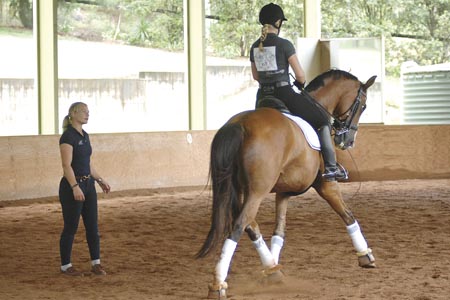 The horse is seriously talented, but Hayley wanted to impress upon Jessica that without suppleness in the body, the movement becomes punchy instead of expressive:
The horse is seriously talented, but Hayley wanted to impress upon Jessica that without suppleness in the body, the movement becomes punchy instead of expressive:
“For me there’s too much happening in front and that’s why you’ve got a few problems in the Grand Prix. The basics aren’t easy enough, some of the questions you ask are too complicated. You need to keep it simple, they’re just horses. Sure, they’re pretty cluey, but they learn from repetition, make it easy for him to understand.”
“In the half pass you’re riding with too much flexion in the neck which is pushing the shoulders in the opposite direction and the arse is trying to lead. You’re lucky, because he’s talented, the legs keep going, but on the next horse, if you ride with a bend like that, you might not be so lucky. You see it so often, they’re trotting beautifully, then they go half pass and it’s scurry, scurry, scurry. Everything has to connect, the piaffe has to come into the passage, passage has to come into the trot, the trot should never deteriorate in any exercise.”
First Hayley wanted to see the horse more through in the body: “Ride shoulder-in left, put your hands down here, so you’ve got a connection to both hands, it’s very Isabell. You’re missing a true connection, never bring your hands backwards, you’re riding on a closed back. Try to think he’s got to come over the shoulders, keep the right hand over the right shoulder. I want to see the neck down, make one silhouette. Push his belly to the right so he gets more moveable in the middle of his body. Stop over-riding the trot, come down a level, relax. This is not a competition, I don’t want him climbing up stairs so much, I want him rounder, I want one horse, not two horses. That’s it! Can you feel the difference? That’s connection.”
The connection must be established before asking for more expression, or as Hayley put it: “When you have a true connection you have true control, when you have true control you can allow him independence, and then you can allow the party to begin. Don’t start a party without any rules.”
When the core of the horse is supple, swing and expression become inevitable: “You don’t need to create, he’s got quality enough. We’re not riding for auctions and stallion shows and the sport has changed. You see Totilas perform like he does because the basics underneath are so brilliant. When Edward was riding him he could access any gear at any moment, and if a mistake came he could quickly resolve it. I think that’s what it’s got to come down to, harmony. The days when you could come onto the international stage and boom, boom, boom, don’t exist anymore. It’s all got to be about creating an athlete, and if he’s going like this (punching fists) he’s not going to last. The softer the connection, the softer the movement, we don’t want it to be mechanical. Think of those amazing latino dancers, think about everything being loose and supple and athletic.”
It’s not just a question of improving the pace, but of longevity: “Horses break down, if they’re like this (Hayley punches her fists) they’re strong in the back, they’re strong on the ground, and they break. If they’re soft in the back, they’re soft on the ground. I always say we’ve got twenty years of riding in a horse and you can use that up over two years, or over twenty-five years, it depends where you’re coming from, it’s about how you manage those miles.”
With this in mind they got back to the half pass left: “Half halt, take a little of the power out of the front and balance him to the back, that’s it. Sit, don’t panic. Now come on the diagonal. Imagine there is a wall on your right side and only ride travers, not half pass, look at the marker at the end of the diagonal. Come with his ears and his shoulders and your shoulders all looking to the marker, your shoulders should be the same as his. Let him come round, hands wide, they’re your training wheels, control the shoulders, and swing your hips through the middle of your hands.”
Parador was impressive in the half pass before, but with everything moving in the right direction he gets an extra inch in his stride: “That’s the best half pass you’ve done. We riders complicate everything, let him be rounder, let the nose out, that’s what I want, the nose is centred now huh? That’s a feeling.”
Hayley’s years of training in Germany have made her determined to be a good communicator: “It’s really hard in Germany, they don’t tell you how to train, you have to look in the mirror, all you can do is watch them. With me, I had to find little ways to get there, to get the feeling they had.” Well, luckily for us, Hayley is one hell of a talker, and next month she reveals her secret to riding one of the more troublesome movements in the Grand Prix – the canter zig zag.

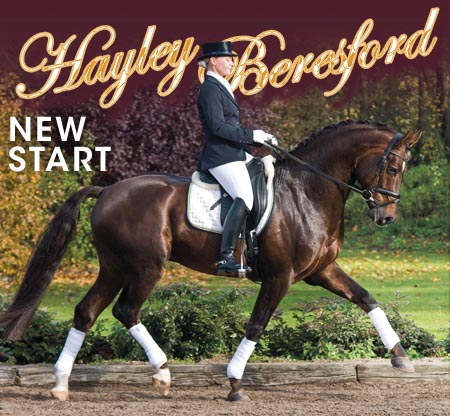
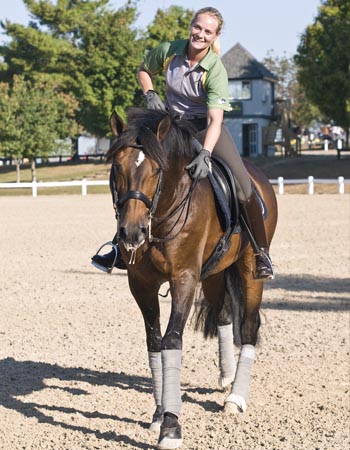
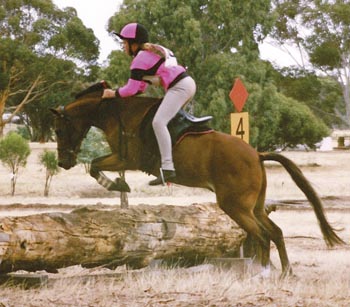
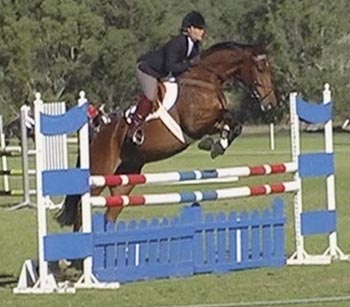
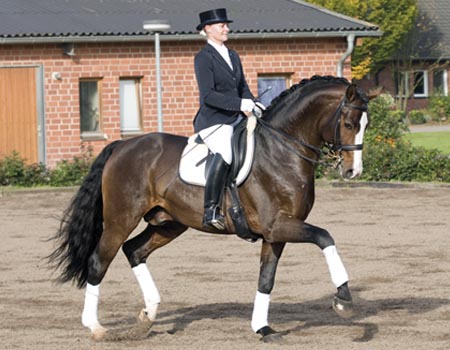
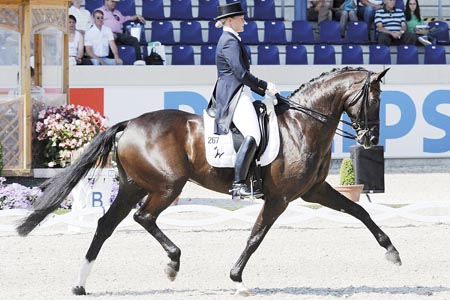
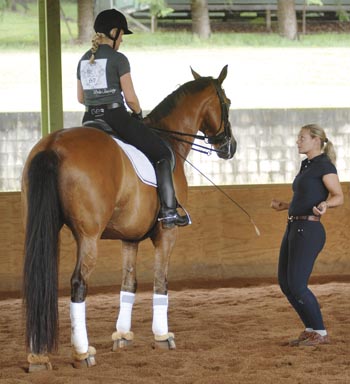
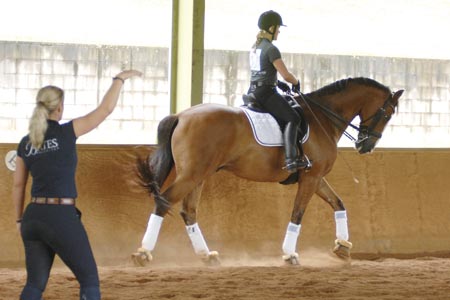
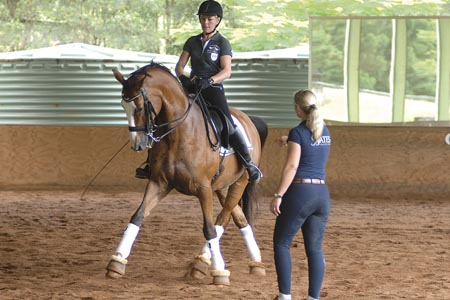
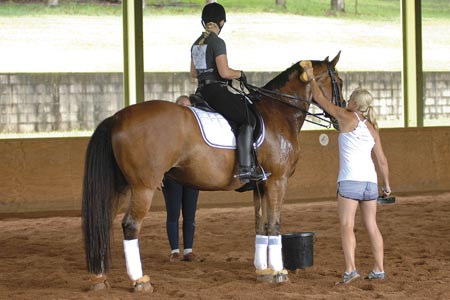
Absolutely brilliant! Hayley sounds like an amazing trainer with really spot-on ideas. It is great that she goes back to Australia and shares her knowledge 🙂
loveng horses myself she is an inspiration to me. in 15 terning 16 in march and have a horse that is a little difecult to ride but Hayley has helped me over come my fear of riding my horse